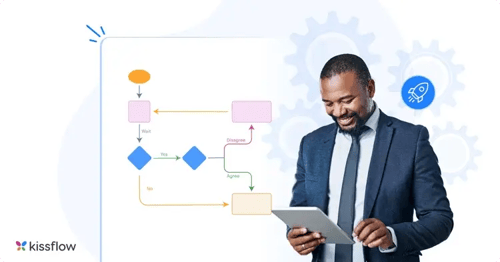
A project is defined as a sequence of tasks that must be completed to attain a certain outcome. According to the Project Management Institute (PMI), the term Project refers to ” to any temporary endeavor with a definite beginning and end”. Depending on its complexity, it can be managed by a single person or hundreds.
Characteristics of a project
A project is a set of interdependent tasks that have a common goal. Projects have the following characteristics:

- A clear start and end date – There are projects that last several years but a project cannot go on forever. It needs to have a clear beginning, a definite end, and an overview of what happens in between.
- A project creates something new – Every project is unique, producing something that did not previously exist. A project is a one-time, once-off activity, never to be repeated exactly the same way again.
- A project has boundaries – A project operates within certain constraints of time, money, quality, and functionality. We’ll see more about this in later sections.
- A project is not business as usual – Projects are often confused with processes. A Process is a series of routine, predefined steps to perform a particular function, say, expense reimbursement approvals. It’s not a one-off activity. It determines how a specific function is performed every single time
The diverse nature of projects
Projects come in a wide range of shapes and sizes.
A project can:
- Be big: Like the construction of the Hoover Dam, take years to complete, and have a humongous budget.
- Be small: Like your weekend project of installing a pathway in your lawn
- Involve many people: Like planning a wedding
- Just yourself: rearranging the photos in your wedding album
Turn project concepts into seamless execution with workflow software that automates tasks and improves visibility.
Types of projects
Projects can be diverse in the ways in which they are implemented. Here are some examples of projects:
- Traditional projects: These are run sequentially in phases. These phases are typically initiation, planning, execution, monitoring, and closure. Most high-cost infrastructure projects make use of traditional project management.
- Agile projects: These are used mainly in software development. They are people-focused and adaptive. They also typically have short turnaround times.
- Remote projects: Remote project management is usually used by distributed teams that seldom meet in person. Handling freelance contributors is an example of a remote project.
- Agency projects: Agency projects are outsourced to an agency that is likely to have projects with multiple clients. Marketing and design projects are commonly outsourced to agencies.
The boundaries of a project
Every project operates within certain boundaries called constraints:
- Project scope
- Project schedule
- People
- Resources.

All of these project constraints depend on what the project aims to achieve and when. The outcome of a project results in deliverables. Anything that’s produced during the project’s development such as documents, plans, and project reports is considered a deliverable. A deliverable may also be the result of the project itself.
Having a final deliverable, as well as a finite timespan, distinguishes project management from business-as-usual operations. Since projects are unlike routine operations, most people involved are those who usually don’t work together. Sometimes, the professionals involved will come from different organizations and geographies. If the desired outcome is achieved on time and within budget, a project is considered to be a success.
Build faster, spend less. Kissflow quantifies the real impact of low-code adoption.
Project life cycle – 5 stages
Often, projects are divided into five project phases each of which comes with a distinct set of tasks, objectives, and a particular deadline. Dividing a project into different phases enables teams to stay on track throughout their entire life cycle.
1. Initiation
The first phase in a project’s life cycle is called project initiation. Here, a project officially launches. It is named, and a broad plan is defined. Goals are identified, along with the project’s constraints, risks, and shareholders. At this point, shareholders decide if they want to commit to the project.
Depending on the project, studies may be conducted to identify its feasibility. For IT projects, requirements are usually gathered and analyzed during the initiation phase.
2. Planning
A roadmap that will guide teams from creating a project plan throughout the project’s execution and closure phases is developed comprehensively during the planning stage. Deadlines must be set, and resources must be allotted. Breaking down tasks into smaller, manageable activities makes it easier to manage project risks, costs, quality, time, and so on.
At the same time, breaking down tasks into digestible pieces will empower everyone involved to accomplish the project on time and stay within budget.
3. Execution
The project plan is implemented during the project execution phase. At this point, teams will work on the deliverables to ensure that the project meets the necessary requirements.
Everyone usually gathers for a meeting to mark the official start of the project, where teams can get acquainted with each other and discuss their roles in the success of the project. Modes of communication and project management tools are identified before the project plan is executed.
In addition, team members familiarize themselves with the necessary status meetings and reports that will be conducted throughout this phase to collect project metrics. The project execution phase is a critical point in a project’s life cycle as it will help everyone determine if their efforts will ultimately be fruitful or not.
4. Monitoring and Controlling
The project monitoring and controlling phase happen at the same time as the execution phase. It’s the job of the project manager to oversee operations and make sure that everything is headed in the right direction, according to plan.
Aside from overseeing the project’s performance, project managers have to monitor resources, manage risks, head status meetings, and reports, etc. If unforeseen issues arise, the project manager may have to make adjustments to the plans, as well as the project schedule.
5. Closing
The final phase of the project management life cycle known as the project closure phase isn’t as simple as delivering the output itself. Project managers have to record all deliverables, organize documents in a centralized location, and hand over the project to the client or the team responsible for overseeing its operations during the project closure phase.
Not only that, but teams come together for a final meeting to discuss the insights they’ve learned and to reward the hard work of each member.
When is a project considered a success?
The short of it is that a project that is completed on time and on a budget can be considered a success. However, a project can be evaluated on many criteria:
- Does it meet business requirements?
- Is it delivered on schedule and on a budget?
- Does it deliver the expected value and ROI?
What defines a successful project is likely to change based on the type of project. This is why it is important to define what project success means during the initiation and planning phases of a project.
Low code platform for Middle East.
How to implement a project
Project implementation can vary based on the methodology used. In traditional project management, implementation is done in 5 phases.
- Initiation: This phase involves making the case for the project to convince the project stakeholders. A Project Initiation Document (PID) is created with basic information about the project including probable resource use and feasibility.
- Planning: This phase occurs once a project has received approval from stakeholders. This is a critical phase that involves a myriad of tasks including contingency planning, allocating tasks, and planning resource sharing.
- Execution: This is the phase when the actual work happens. Periodical reviews are conducted to ensure that execution happens within schedule.
- Monitoring: Monitoring happens in tandem with execution. Constant monitoring by the project manager is required to ensure that work goes on minus hiccups.
- Closure: This phase involves the important final tasks in the project including project delivery to the client and documenting the learnings from the project.
Once these steps are complete, a project can be said to be implemented well.
Turn project ideas into execution with a no-code platform that simplifies setup, automates tasks, and accelerates delivery.
How project management helps you manage projects
Projects can be very complex undertakings that require a huge amount of effort and resources. No matter what the goal is, using project management principles will help the initiative run smoothly. Without proper project management principles, projects will be handled haphazardly and are at a much higher risk of
- project failure,
- delay in the project, and
- being over budget.
Knowing the fundamentals of project management improves one’s chances of completing a project successfully. No matter what industry or niche an organization is in, project management methodologies and frameworks enable them to steer the project in the right direction. Explore how Kissflow platform can streamline your project management processes. Whether you're an IT Leader, Developer, Process Owner, or Business Manager, low-code is transforming the way enterprises build applications. Unlock agility and innovation with Kissflow.
Supercharge project management with low-code: Build custom workflows, automate approvals, and track progress in real time.
See how Kissflow delivers the fastesttime-to-value in the market
Your search for Project Management has landed you here. Wondering why?
As a user, you'll experience the full value of Kissflow by implementing it across departments for diverse use cases rather than just addressing isolated needs like a project management tool for a single team or department.
Related Articles


-May-19-2025-11-22-41-6975-AM.png)




